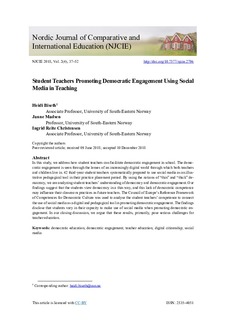| dc.contributor.author | Biseth, Heidi | |
| dc.contributor.author | Madsen, Janne | |
| dc.contributor.author | Christensen, Ingrid Christine Reite | |
| dc.date.accessioned | 2019-01-18T09:26:46Z | |
| dc.date.available | 2019-01-18T09:26:46Z | |
| dc.date.created | 2018-12-18T11:57:24Z | |
| dc.date.issued | 2018 | |
| dc.identifier.citation | Nordic Journal of Comparative and International Education (NJCIE). 2018, 2 (4), 37-52. | nb_NO |
| dc.identifier.issn | 2535-4051 | |
| dc.identifier.uri | http://hdl.handle.net/11250/2581232 | |
| dc.description | This work is licensed under a Creative Commons Attribution 4.0 International License. | nb_NO |
| dc.description.abstract | In this study, we address how student teachers can facilitate democratic engagement in school. The demo-cratic engagement is seen through the lenses of an increasingly digital world through which both teachers and children live in. 42 third-year student teachers systematically prepared to use social media as an illus-trative pedagogical tool in their practice placement period. By using the notions of “thin” and “thick” de-mocracy, we are analyzing student teachers’ understanding of democracy and democratic engagement. Our findings suggest that the students view democracy in a thin way, and this lack of democratic competence may influence their classroom practices as future teachers. The Council of Europe’s Reference Framework of Competences for Democratic Culture was used to analyse the student teachers’ competence to connect the use of social media as a digital and pedagogical tool in promoting democratic engagement. The findings disclose that students vary in their capacity to make use of social media when promoting democratic en-gagement. In our closing discussion, we argue that these results, primarily, pose serious challenges for teacher education. | nb_NO |
| dc.language.iso | eng | nb_NO |
| dc.rights | Navngivelse 4.0 Internasjonal | * |
| dc.rights.uri | http://creativecommons.org/licenses/by/4.0/deed.no | * |
| dc.title | Student Teachers Promoting Democratic Engagement Using Social Media in Teaching | nb_NO |
| dc.type | Journal article | nb_NO |
| dc.type | Peer reviewed | nb_NO |
| dc.description.version | publishedVersion | nb_NO |
| dc.source.pagenumber | 37-52 | nb_NO |
| dc.source.volume | 2 | nb_NO |
| dc.source.journal | Nordic Journal of Comparative and International Education (NJCIE) | nb_NO |
| dc.source.issue | 4 | nb_NO |
| dc.identifier.doi | 10.7577/njcie.2796 | |
| dc.identifier.cristin | 1644782 | |
| cristin.unitcode | 222,59,3,0 | |
| cristin.unitcode | 222,59,7,0 | |
| cristin.unitname | Institutt for kultur, religion og samfunnsfag | |
| cristin.unitname | Institutt for pedagogikk | |
| cristin.ispublished | true | |
| cristin.fulltext | original | |
| cristin.qualitycode | 1 | |

